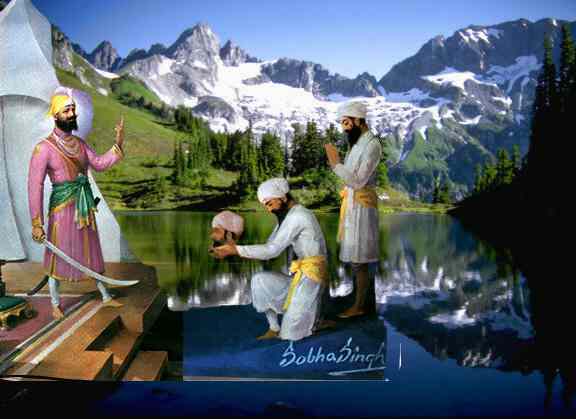
"Creation of the Khalsa" Harjinder Singh Kanwal
There has been quite a controversy on how the "Khalsa"(the pure) was created by Guru Gobind Singh Ji in 1699 AD. The incident, in many different ways ,has been narrated by different authors who have either copied their predecessors or given an account of the "Vaisakhi Khalsa Creation" in a manner which suited their own logic . So far none of the accounts have a definite ring of truth in them. There are mainly three versions of the 'Creation of Khalsa' that can become a subject of a major debate amongst the sikh scholars.
The first version is that Guru Ji held a 'darbar'(congregation) at 'Kesgarh Sahib' at Anandpur and amidst the 'Sangat'(disciples) drew his sword and demanded 'heads' of the sikhs present in the audience. One at a time the Five 'Pyaras' (loved ones) came on the stage and offered their heads to the Guru, who took them inside a tent . When he came back, he was wielding a blood dripping sword with which he had beheaded a goat previously tied inside the tent. Thus it is understandable that instead of the 'Pyaras', five goats were slaughtered. Guru Ji prepared a nectar and baptized them and presented them to the 'Sangat' with their new changed names as Daya Singh, Dharam Singh, Himmat Singh, Mohkam Singh, and Sahib Singh.
The other version is similar to the above with the exception that Guru Ji took each 'Pyara' into the tent and came out of the tent brandishing a bloodstained sword. What happened in the tent is a mystery. The killing of goats is not an issue here.
The third version is very interesting and is a record of accounts that are supposedly eye-witnessed by a certain "Abu-ul-Turani", who was under the employment of Emperor Aurangzeb. The Emperor had instructed him to keep a watchful eye on the Guru and act as the Emperor's informer to keep him (the Emperor) informed of all the activities and movements of the Guru. The following is the version which 'Abu-ul-Turani' has narrated in his book or memoirs presumed to be held in the archives of the Aligarh University.
"The day Guru Gobind Singh prepared the nectar at 'Anandpur' the congregation was estimated to around thirty five to forty thousand sikhs who had come from far and wide. I had seen the grandeur of the 'Mughal Darbars' but this 'Guru's Darbar' had a charm of its own - simply majestic and beyond comparison.
The Guru came on the stage and after drawing his sword demanded a 'head' from the 'Sangat' present. This awesome call from the Guru sent a shiver to spines of the sikhs present in the congregation. Amidst all this a brave person emerged from the crowd and with his clasped hands humbly presented himself to the Guru. The Guru, with one stroke if his sword, beheaded the sikh in front of all the stunned 'sangat', and again asked for another 'head'. Another person who came on the stage was similarly beheaded. The Guru made the eerie call again and simultaneously three devout sikhs came on the stage and met the same fate under the merciless sword of the Guru. The stage was a ghastly sight with the torsos and heads of the five drenched in pools of blood. All the trace of blood diminished after the Guru cleaned it with water. The Guru then medically joined each head on a different body and thereafter covered them with white sheets.
He then ordered a stone urn and on top of it he put an iron pot in which he added some water. He put his sword in it and started moving it, while chanting some words. He took some time and during this period some woman from the Guru's household came and put something in the pot. The nectar (Abe-Hayat) was now ready. The Guru then removed the white sheets from one body and poured the nectar into the dead man's mouth, on the hair and on the body. While he was performing this ritual he kept on pronouncing "Waheguru ji ka Khalsa, Waheguru ji ki Fateh"( The Khalsa belongs to the Almighty and to the Almighty is the victory ). To the amazement of the 'sangat', the person sat up and loudly chanted "Waheguru ji ka Khalsa, Waheguru ji ki Fateh".
The whole congregation was aghast and taken aback by this miracle. The Guru did the same to the rest of the four bodies and they also like their counterpart rose up with shouts of "Waheguru ji ka Khalsa, Waheguru ji ki Fateh". The Guru then took these five sikhs into a tent and after some time they emerged wearing new white clothes. The Guru then kneeled down in front of them and asked them to give him the life giving nectar. Obligingly they obeyed and baptized the Guru .
The Guru named them Daya Singh, Dharam Singh, Himmat Singh, Mohkam Singh and Sahib Singh and consequently changed his name from Gobind Rai to Gobind Singh. What happened in front of my eyes completely entranced me, and my heart longed to be in the Guru's eternal feet. With a lump in my throat, I approached the Guru and begged him to baptize me and take me in his abode. The Guru smiled and baptized me and named me 'Ajmer Singh'. Thus with the Guru's blessing I attained absolute bliss. This was the last report I sent to Aurangzeb in which I mentioned that the Guru was not an ordinary person but was 'Allah' Himself. Furthermore I warned the Emperor that his enmity towards the Guru will lead to the downfall and destruction of the Mughal Empire."
The above narration of 'Abu-ul-Turani' does carry considerable weight, but it requires more research and looking into . I appeal to our scholars and 'prabandhak committees' to explore this subject with interest and an impartial mind.